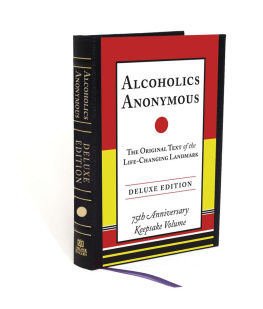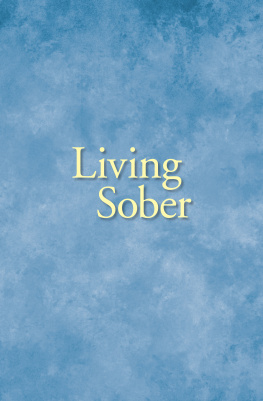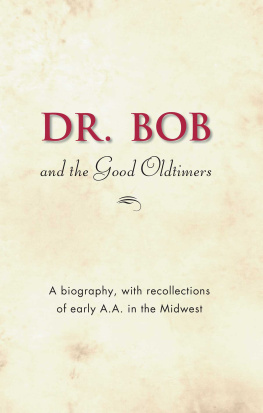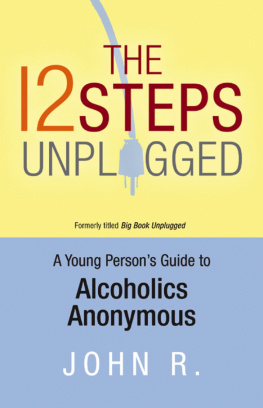alcoholics
anonymous
THE BIG BOOK
T HE O RIGINAL 1939 E DITION
BILL W.
W ITH A N EW I NTRODUCTION
BY
DICK B.
D OVER P UBLICATIONS , I NC .
M INEOLA , N EW Y ORK
Introduction to the Dover Edition Copyright 2011 by Dick B.
Bibliographical Note
This Dover edition, first published in 2011, is a republication of the work originally published in 1939 by Works Publishing Company, New York. The only alteration in the text is the omission of the two page Appendix at the end of the original edition.
Library of Congress Cataloging-in-Publication Data
W., Bill
Alcoholics Annoymous : the original 1939 edition / Bill W.
p. cm.
Reprint. Originally published as: Alcoholics Aninymous : the story of how more than one hundred men have recovered from alcoholism.
Originally published in 1939 by Works Publishing Company, New York.
eISBN 13: 978-0-48-617376-4
ISBN-10: 0-486-48059-3
1. AlcoholismTreatment. 2. AlcoholicsRehabilitation. 3. Psychology, Religious. 4. Twelve-step programs. 5. Alcoholics Anonymous. I. Alcoholics Anonymous. II. Title.
HV5275.W15 2011
362.29286dc22
2010054007
Manufactured in the United States by Courier Corporation
48059301
www.doverpublications.com
CONTENTS
CHAPTER
INTRODUCTION TO THE DOVER EDITION
This first edition of Alcoholics Anonymous was intended to show any and all those afflicted with, or affected by, alcoholism that alcoholics could completely recover if they thoroughly followed this books suggested path. It was designed to tell alcoholics precisely how to proceed. The personal stories included in the book furnished the evidence that victory had been achieved by those who really tried and followed directions.
A Pathway to a Cure for the Seemingly-Hopeless, Powerless, Alcoholic
It is as important to learn how this first edition came about, as it is to ask why it is of importance today.
A major key to the how and why has to do with what the author, Bill Wilson, and his partner, Henry Parkhurst, proposed to accomplish as they began to put the pages together.
The Cure: Wilson and Parkhurst believed they had found a cure for alcoholism.
The two men wanted to describe their cure and also to prove its effectiveness through personal testimoniesstories written by those who had followed the instructions of the program.
They said clearly that their new book was written to promote and describe a cure for alcoholism. In the initial outline Parkhurst wrote for the book, he stated that the books title page should read:
Alcoholics Anonymous
Published by ALCOHOLICS ANONYMOUS, Inc.
A Non Profit Organization for the Promotion of Cure and Understanding of Alcoholism
Both of A.A.s cofounders (Bill Wilson and Dr. Bob Smith) made it equally clear that they themselves had been cured.
On of the fourth edition of Alcoholics Anonymous, published in 2001, Bill Wilson is quoted as saying to the wife of A.A. Number Three, Bill D.:
Henrietta, the Lord has been so wonderful to me, curing me of this terrible disease, that I just want to keep talking about it and telling people.
In his article titled I Saw Religion Remake A Drunkard in the September 1939 issue of Your Faith magazine, D. J. Defoe said of his interview with Dr. Bob (whom Defoe identified only as Dr. X in the article):
When the time came to talk, he [Dr. Bob] told how he had been cured of drunkenness by prayer.
Dr. Bob added:
We cant publicize these cures. These men are outside the realm of everyday medicine. They have tried everything and been given up as hopeless. We dont succeed every time ourselves. We cant brag. Every case is a new battle.
One of the front covers proposed for the dust jacket of the first edition of Alcoholics Anonymous underlined the cure promotion. The coverdesigned by Ray C., a New York artistdepicted a man marching forward with fists clenched and a determined look on his face. In the background was a bottle with another man trapped inside. The books title, Alcoholics Anonymous, was written in red and took up most of the cover; and a proposed subtitle, Their Pathway to a Cure, was written in the lower right-hand corner.
The Personal Stories Testifying to the Experiences of the Pioneers Who Sought the Cure
Wilson and Parkhurst decided to document their claimed cure with the testimonies of 29 pioneers. In company with Dr. Bob, they gathered a limited number of testimoniestwo thirds of which came from members of the Akron Fellowship. Some of the stories described members who had successfully maintained recovery without a slip (i.e., a relapse). Others described members who had gotten sober and slipped, but had returned to succeed later.
The stories of A.A.s pioneers were intended to provide: (1) the experiences of a cross-section of the original A.A.swarts and all; (2) a demonstration of how much the program ideas had impacted those pioneers; and (3) recitals that illustrated the case-by-case battle to which Dr. Bob humbly and honestly referred in the Defoe article mentioned earlier.
Regrettably, 22 of the 29 original testimonials in the Personal Stories section of the first edition were not included in the second edition. (The same 22 stories were also left out of the third and fourth editions.) And another four of the original stories were omitted from the fourth edition, leaving only three of the original 29 stories in the fourth edition. These three were (and are): (1) Dr. Bobs Nightmare; (2) Our Southern Friend; and (3) The Fearful One (renamed The Man Who Mastered Fear in following editions).
A few of the members whose stories were included in the first edition got drunk after Alcoholics Anonymous was published in April 1939, and their stories were removed from future editions. Note the discussion of the stories found on an unnumbered page (equivalent to ) in the Personal Stories section of the second edition, published in 1955:
When first published in 1939, this book carried twenty-nine stories about alcoholics.
To secure maximum identification with the great number of readers, the new Second Edition (1955) carries a considerably enlarged story section, as above described.
Concerning the original twenty-nine case histories, it is a deep satisfaction to record, as of 1955, that twenty-two have apparently made full recovery from their alcoholism. Of these, fifteen have remained completely sober for an average of seventeen years each, according to our best knowledge and belief.
Todays A.A. reader can learn much from the astonishing success of the early program as it is revealed in the body of stories contained in the first edition. A knowledge of the successes, the failures, and the relapsed returners will help to provide a realistic understanding of how the challenging program originally worked. Also as to what can reasonably be expected today. And what the pioneers were told to do, what they grasped, what they accepted or rejected, and what the consequences were, regardless of their particular success or failure, still has value today.
The stories included in the first edition provide considerable insight regarding the early program that really put A.A. on the map. And 21st century readers miss much if they simply read the multiple stories in later editions that have almost completely replaced those the reader will find in this first edition.
The Original Recovery Plan for the First Edition
Parkhurst wrote an outline for the proposed book. (And, as mentioned earlier, the outline suggested that the Title Page for the book should include this statement: Published by ALCOHOLICS ANONYMOUS, Inc., A Non Profit Organization for the Promotion of Cure and Understanding of Alcoholism.)







